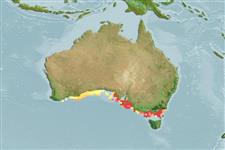>
Atheriniformes (Silversides) >
Atherinidae (Silversides) > Atherininae
Etymology: Kestratherina: Greek, kestra, -as = grey mullet +Greek, atherina, the Greek name for the eperlane; 1770 (Ref. 45335).
More on author: Klunzinger.
Environment: milieu / climate zone / depth range / distribution range
Ekologi
marina; brackvatten. Temperate; 32°S - 40°S
Eastern Indian Ocean: endemic to southern Australia.
Size / Vikt / Age
Maturity: Lm ? range ? - ? cm
Max length : 15.0 cm TL hane/ej könsbestämd; (Ref. 33839)
Found in inshore waters (Ref. 7300). A schooling species (Ref. 75154).
Life cycle and mating behavior
Könsmognad | Reproduktion | Lek | Ägg | Fecundity | Larver
Paxton, J.R., D.F. Hoese, G.R. Allen and J.E. Hanley, 1989. Pisces. Petromyzontidae to Carangidae. Zoological Catalogue of Australia, Vol. 7. Australian Government Publishing Service, Canberra, 665 p. (Ref. 7300)
IUCN Red List Status (Ref. 130435: Version 2024-1)
Threat to humans
Harmless
Human uses
Verktyg
Special reports
Download XML
Internet-källor
Estimates based on models
Preferred temperature (Ref.
123201): 15.1 - 17.9, mean 16.4 °C (based on 54 cells).
Phylogenetic diversity index (Ref.
82804): PD
50 = 0.7500 [Uniqueness, from 0.5 = low to 2.0 = high].
Bayesian length-weight: a=0.01000 (0.00244 - 0.04107), b=3.04 (2.81 - 3.27), in cm total length, based on all LWR estimates for this body shape (Ref.
93245).
Trofisk nivå (Ref.
69278): 4.1 ±0.0 se; based on diet studies.
Resiliens (Ref.
120179): Mellan, lägsta populationsfördubblingstid 1,4-4,4 år (Preliminary K or Fecundity.).
Fishing Vulnerability (Ref.
59153): Low vulnerability (10 of 100).
